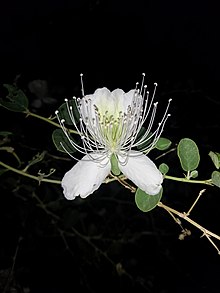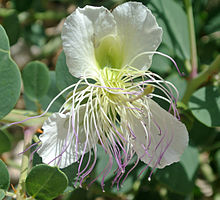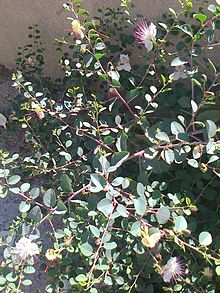| Capparis spinosa | |
|---|---|

| |
| Illustration by Otto Wilhelm Thomé | |
| Conservation status | |
 Least Concern (IUCN 3.1) | |
| Scientific classification | |
| Kingdom: | Plantae |
| Clade: | Tracheophytes |
| Clade: | Angiosperms |
| Clade: | Eudicots |
| Clade: | Rosids |
| Order: | Brassicales |
| Family: | Capparaceae |
| Genus: | Capparis |
| Species: | C. spinosa |
| Binomial name | |
| Capparis spinosa Linnaeus, 1753 | |
| Synonyms | |
Synonymy
| |

Capparis spinosa, the caper bush, also called Flinders rose, is a perennial plant that bears rounded, fleshy leaves and large white to pinkish-white flowers.
The taxonomic status of the species is controversial and unsettled. Species within the genus Capparis are highly variable, and interspecific hybrids have been common throughout the evolutionary history of the genus. As a result, some authors have considered C. spinosa to be composed of multiple distinct species, others that the taxon is a single species with multiple varieties or subspecies, or that the taxon C. spinosa is a hybrid between C. orientalis and C. sicula.
Capparis spinosa is native to almost all the circum-Mediterranean countries, and is included in the flora of most of them, but whether it is indigenous to this region is uncertain. The family Capparaceae could have originated in the tropics and later spread to the Mediterranean basin.
The plant is best known for the edible flower buds (capers), used as a seasoning or garnish, and the fruit (caper berries), both of which are usually consumed salted or pickled. Other species of Capparis are also picked along with C. spinosa for their buds or fruits. Other parts of Capparis plants are used in the manufacture of medicines and cosmetics.
Description


The shrubby plant is many-branched, with alternate leaves, thick and shiny, round to ovate. The flowers are complete, sweetly fragrant, and showy, with four sepals and four white to pinkish-white petals, many long violet-coloured stamens, and a single stigma usually rising well above the stamens.
Accepted infraspecifics
Eleven subspecies and variants are accepted, according to Plants of the World Online:
- Capparis spinosa var. aegyptia (Lam.) Boiss.
- Capparis spinosa var. atlantica (Inocencio, D.Rivera, Obón & Alcaraz) Fici
- Capparis spinosa var. canescens Coss.
- Capparis spinosa subsp. cordifolia (Lam.) Fici
- Capparis spinosa var. herbacea (Willd.) Fici
- Capparis spinosa var. mucronifolia (Boiss.) Hedge & Lamond ex R.R.Stewart
- Capparis spinosa var. myrtifolia (Inocencio, D.Rivera, Obón & Alcaraz) Fici
- Capparis spinosa var. ovata (Desf.) Sm.
- Capparis spinosa subsp. parviflora (Boiss.) Ahmadi, H.Saeidi & Mirtadz.
- Capparis spinosa subsp. rupestris (Sm.) Nyman
- Capparis spinosa subsp. spinosa
Capparis nummularia was formerly considered a subspecies of Capparis spinosa.
Distribution and habitat
Capparis spinosa ranges around the Mediterranean Basin, Arabian Peninsula, and portions of Western and Central Asia.
In southern Europe, it is found in southern Portugal, southern and eastern Spain (including the Balearic Islands), Mediterranean France including Corsica, Italy including Sicily and Sardinia, Croatia's Dalmatian islands, Albania, Greece and the Greek Islands, western and southern Turkey, on Cyprus, and on the Crimean Peninsula in Ukraine. In Spain, it ranges from sea level up to 1,300 metres (4,300 ft) in elevation.
In northern Africa, it is found throughout the north and the Atlas Mountains of Morocco, where it occurs from sea level up to 2,000 m (6,600 ft) in elevation. It is also found in northern Algeria (Kabylie, coastal Algeria, Bouzaréa, and Oran) and the Hoggar Mountains of the Algerian Sahara, in Tunisia north of the Sahara, and Cyrenaica in Libya.
In western Asia, it is found along the eastern Mediterranean in Lebanon, Israel, Syria, and western Jordan, and in the southern Sinai Peninsula of Egypt. It is also found south of the Caucasus in Armenia, Azerbaijan, Georgia, and northeastern Turkey. On the Arabian Peninsula it occurs in Oman, Yemen including Socotra, and Asir province of Saudi Arabia. In central Asia, it inhabits the mountains of central Afghanistan, the lower Karakoram range in northern Pakistan and Ladakh, and Tajikistan, Kyrgyzstan, and eastern Uzbekistan.
Environmental requirements


The caper bush requires a semiarid or arid climate. The caper bush has developed a series of mechanisms that reduce the impact of high radiation levels, high daily temperature, and insufficient soil water during its growing period.
In response to sudden increases in humidity, the bush forms wart-like pockmarks across the leaf surface. It quickly adjusts to the new conditions and produces unaffected leaves.
Agriculture

Capers can be grown easily from fresh seeds gathered from ripe fruit and planted into a well-drained seed-raising mix. Seedlings appear in two to four weeks. Old, stored seeds enter a state of dormancy and require cold stratification to germinate. The viable embryos germinate within three to four days after partial removal of the lignified seed coats. The seed coats and the mucilage surrounding the seeds may be ecological adaptations to avoid water loss and conserve seed viability during the dry season.
Orchard establishment
Mean annual temperatures in areas under cultivation are over 14 °C (57 °F). A rainy spring and a hot, dry summer are considered advantageous. This drought-tolerant perennial plant is used for landscaping and reducing erosion along highways, steep rocky slopes, dunes or fragile semiarid ecosystems.
Harvest
Caper buds are usually picked in the morning. Because the youngest, smallest buds fetch the highest prices, daily picking is typical.
Capers may be harvested from wild plants, in which case it is necessary to know that the plant is not one of the few poisonous Capparis species that look similar. The plant normally has curved thorns that may scratch the people who harvest the buds, although a few spineless varieties have been developed.
Uses
| Nutritional value per 100 g (3.5 oz) | |||||||||||||||||||||||||||||||||||||||||
|---|---|---|---|---|---|---|---|---|---|---|---|---|---|---|---|---|---|---|---|---|---|---|---|---|---|---|---|---|---|---|---|---|---|---|---|---|---|---|---|---|---|
| Energy | 96 kJ (23 kcal) | ||||||||||||||||||||||||||||||||||||||||
| Carbohydrates | 5 g | ||||||||||||||||||||||||||||||||||||||||
| Sugars | 0.4 g | ||||||||||||||||||||||||||||||||||||||||
| Dietary fiber | 3 g | ||||||||||||||||||||||||||||||||||||||||
| Fat | 0.9 g | ||||||||||||||||||||||||||||||||||||||||
| Protein | 2 g | ||||||||||||||||||||||||||||||||||||||||
| |||||||||||||||||||||||||||||||||||||||||
| Other constituents | Quantity | ||||||||||||||||||||||||||||||||||||||||
| Water | 83.8 g | ||||||||||||||||||||||||||||||||||||||||
| Selenium | 1.2 μg | ||||||||||||||||||||||||||||||||||||||||
Link to USDA Nutrient Database Entry | |||||||||||||||||||||||||||||||||||||||||
| Percentages estimated using US recommendations for adults, except for potassium, which is estimated based on expert recommendation from the National Academies. | |||||||||||||||||||||||||||||||||||||||||
Nutrition
Canned, pickled capers are 84% water, 5% carbohydrates, 2% protein, and 1% fat. Preserved capers are particularly high in sodium due to the amount of salt added to the brine. In a typical serving of 28 grams (one ounce), capers supply 6 kcal and 35% of the Daily Value (DV) for sodium, with no other nutrients in significant content. In a 100-gram amount, the sodium content is 2960 mg or 197% DV, with vitamin K (23% DV), iron (13% DV), and riboflavin (12% DV) also having appreciable levels.
Culinary

The salted and pickled caper bud (simply called a "caper") is used as an ingredient, seasoning, or garnish. Capers are a common ingredient in Mediterranean cuisine, especially Cypriot, Italian, Aeolian Greek, and Maltese food. The immature fruit of the caper shrub are prepared similarly and marketed as "caper berries". Fully mature fruit are not preferred, as they contain many hard seeds.
The buds, when ready to pick, are a dark olive green and range in size from under 7 mm (1⁄4 in) to more than 14 mm (1⁄2 in). They are picked, then pickled in salt or a salt and vinegar solution, and drained. Intense flavour, sometimes described as being similar to black pepper or mustard, is developed as glucocapparin, a glycoside organosulfur molecule, is released from each caper bud. This enzymatic reaction leads to the formation of rutin, often seen as crystallized white spots on the surfaces of individual caper buds.
Capers are a distinctive ingredient in Italian cuisine, especially in Sicilian, Aeolian and southern Italian cooking. They are commonly used in salads, pasta salads, meat dishes, and pasta sauces. Examples of uses in Italian cuisine are piccata dishes, vitello tonnato and spaghetti alla puttanesca.
Capers are sometimes an ingredient in tartar sauce. They are often served with cold smoked salmon or cured salmon dishes, especially lox and cream cheese. Capers and caper berries are sometimes substituted for olives to garnish a martini.
Capers are categorized and sold by their size, defined as follows, with the smallest sizes being the most desirable: non-pareil (up to 7 mm), surfines (7–8 mm), capucines (8–9 mm), capotes (9–11 mm), fines (11–13 mm), and grusas (14+ mm). If the caper bud is not picked, it flowers and produces a caper berry. The fruit can be pickled and then served as a Greek mezze.
Caper leaves, which are hard to find outside of Greece or Cyprus, are used particularly in salads and fish dishes. They are pickled or boiled and preserved in jars with brine—like caper buds.
Dried caper leaves are also used as a substitute for rennet in manufacturing high-quality cheese.
Polyphenols
Canned capers contain polyphenols, including the flavonoids quercetin (173 mg per 100 g) and kaempferol (131 mg per 100 g), as well as anthocyanins.
Other uses
Capers are sometimes used in cosmetics.
History
Archaeobotanical evidence of capers has been found in the Mediterranean region and Mesopotamia as early as the upper Paleolithic period.
The caper was used in ancient Greece as a carminative. It is represented in archaeological levels in the form of carbonised seeds and rarely as flower buds and fruits from archaic and classical antiquity contexts. Athenaeus in Deipnosophistae pays a lot of attention to the caper, as do Pliny (NH XIX, XLVIII.163) and Theophrastus.
Etymologically, the caper and its relatives in several European languages can be traced back to Classical Latin capparis, "caper", in turn, borrowed from the Greek κάππαρις, kápparis, whose origin (as with that of the plant) is unknown but is probably Asian. Another theory links kápparis to the name of the island of Cyprus (Κύπρος, Kýpros), where capers grow abundantly.

In Biblical times, the caper berry was supposed to have aphrodisiac properties; the Hebrew word aviyyonah (אֲבִיּוֹנָה) for caperberry is closely linked to the Hebrew root אבה (avah), meaning "desire".
The berries (abiyyonot) were eaten, as appears from their liability to tithes and the restrictions of the 'Orlah. They are carefully distinguished in the Mishnah and the Talmud from the caper leaves, alin, shoots, temarot, and the caper buds, capperisin (note the similarity "caper"isin to "caper"); all of which were eaten as seen from the blessing requirement, and declared to be the fruit of the ẓelaf or caper plant. The "capperisin" mentioned in the Talmud are actually referring to a shell that protected the "abiyyonot" as it grew.
Talmud Bavli discusses the eating of caper sepals versus caper berries, both in Israel and in Syria.
Capers are mentioned as a spice in the Roman cookbook Apicius.
See also
References
- ^ Rankou, H., M'Sou, S., Diarra, A. & Ait Babahmad, R.A. 2020. Capparis spinosa. The IUCN Red List of Threatened Species 2020: e.T137745831A139593491. https://dx.doi.org/10.2305/IUCN.UK.2020-1.RLTS.T137745831A139593491.en. Downloaded on 24 September 2021.
- The Plant List, Capparis spinosa L
- "Capparis spinosa". Germplasm Resources Information Network. Agricultural Research Service, United States Department of Agriculture. Retrieved 11 December 2017.
- Altervista Flora Italiana, Cappero, Kapernstrauch, Capparis spinosa L. includes photos and European distribution map
- Flora of China, 山柑 shan gan, Capparis spinosa Linnaeus, Sp. Pl. 1: 503. 1753.
- "Capparis spinosa L." Atlas of Living Australia.
- Zohary, M. (1960). "The species of Capparis in the Mediterranean and the Near Eastern Countries." Bulletin of the Research Council of Israel, Section D, Botany 8(2): 49-64
- Jacobs, M. (1965). "The genus Capparis (Capparaceae) from the Indus to the Pacific". Blumea. 12: 385–541.
- Heywood V.H. (1993). "Flowering plants of the world." Oxford University Press, New York
- ^ D. Rivera, C. Inocencio, C. Obón, E. Carreño, A. Reales, F. Alcaraz. (2002). "Archaeobotany of capers (Capparis) (Capparaceae)." Vegetation History and Archaeobotany. 11(4): 295–313
- Fici, S. (2001). "Intraspecific variation and evolutionary trends in Capparis spinosa L. (Capparaceae)". Plant Systematics and Evolution. 228 (3–4): 123–141. Bibcode:2001PSyEv.228..123F. doi:10.1007/s006060170024. S2CID 8713605.
- Pugnaire de Iraola, F.I. (1989). "Nota sobre las Capparaceae ibéricas". Blancoana. 7: 121–122.
- Watson, L.; M.J. Dallwitz (1992). "The Families of Flowering Plants". Archived from the original on 1 November 2006. Retrieved 21 November 2006.
- "Capparis spinosa L. | Plants of the World Online | Kew Science". Plants of the World Online. Retrieved 8 December 2024.
- "Capparis spinosa subsp. nummularia (DC.) Fici | Plants of the World Online | Kew Science". Plants of the World Online. Retrieved 8 December 2024.
- Rhizopoulou, S. (1990). "Physiological responses of Capparis spinosa L. to drought." Journal of Plant Physiology 136: 341–348.
- Levizou, E; P. Drilias; A. Kyparissis (2004). "Exceptional photosynthetic performance of Capparis spinosa L. under adverse conditions of Mediterranean summer." Photosynthetica. 42: 229–235
- Sozzi, G.O.; A. Chiesa (1995). "Improvement of caper (Capparis spinosa L.) seed germination by breaking seed coat-induced dormancy". Scientia Horticulturae. 62 (4): 255–261. Bibcode:1995ScHor..62..255S. doi:10.1016/0304-4238(95)00779-S.
- Barbera, B. (1991). Le câprier (Capparis spp.). EUR 13617, Série Agriculture, Programme de recherche Agrimed. Commission des Communautés européennes, Luxembourg, 63 pp.
- ^ Small, Ernest (23 August 2011). Top 100 Exotic Food Plants. Boca Raton, Florida: CRC Press. pp. 121–123. ISBN 978-1439856888.
- United States Food and Drug Administration (2024). "Daily Value on the Nutrition and Supplement Facts Labels". FDA. Archived from the original on 27 March 2024. Retrieved 28 March 2024.
- National Academies of Sciences, Engineering, and Medicine; Health and Medicine Division; Food and Nutrition Board; Committee to Review the Dietary Reference Intakes for Sodium and Potassium (2019). "Chapter 4: Potassium: Dietary Reference Intakes for Adequacy". In Oria, Maria; Harrison, Meghan; Stallings, Virginia A. (eds.). Dietary Reference Intakes for Sodium and Potassium. The National Academies Collection: Reports funded by National Institutes of Health. Washington, DC: National Academies Press (US). pp. 120–121. doi:10.17226/25353. ISBN 978-0-309-48834-1. PMID 30844154. Retrieved 5 December 2024.
- Mike, Tad, "Capers: The Flower Inside", Epikouria Magazine, Fall/Winter 2006
- "USDA Database for the Flavonoid Content of Selected Foods, Release 3, page 16" (PDF). US Department of Agriculture. 2011. Archived from the original (PDF) on 16 July 2012. Retrieved 12 July 2016.
- Mansour, R. B.; Jilani, I. B.; Bouaziz, M; Gargouri, B; Elloumi, N; Attia, H; Ghrabi-Gammar, Z; Lassoued, S (2016). "Phenolic contents and antioxidant activity of ethanolic extract of Capparis spinosa". Cytotechnology. 68 (1): 135–42. doi:10.1007/s10616-014-9764-6. PMC 4698273. PMID 25377263.
- Fragiska, M. (2005). Wild and Cultivated Vegetables, Herbs and Spices in Greek Antiquity. Environmental Archaeology 10 (1): 73–82
- Gernot Katzer. "Spice Pages: Capers (Capparis spinosa)". gernot-katzers-spice-pages.com.
- Kohler, Kaufmann; Hyvernat, Henry (1906). "Caper-berry". The Jewish Encyclopedia.
- See, e.g. Gesenius's lexicon, via Blue Letter Bible
- ^ Talmud Bavli, Brachot 36a-36b
- Kaf HaChaim 208
- Rashi Brachot 36a
External links
- Caper factsheet – NewCROP, Purdue University
- Caperplants
- Brian Noone (2017). Capers: From Wild Harvest to Gourmet Food. Ethelton, S. Aust.: Caperplants. ISBN 9780995353008. OCLC 962480826.
| Taxon identifiers | |
|---|---|
| Capparis spinosa |
|
- IUCN Red List least concern species
- Capparis
- Australian Aboriginal bushcraft
- Bushfood
- Edible plants
- Flora of Australia
- Flora of Europe
- Flora of North Africa
- Flora of Socotra
- Flora of temperate Asia
- Flora of the Hajar Mountains
- Garden plants of Asia
- Garden plants of Europe
- Indian spices
- Medicinal plants of Africa
- Medicinal plants of Asia
- Medicinal plants of Oceania
- Pickles
- Spices